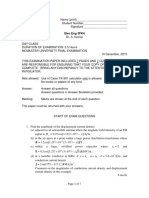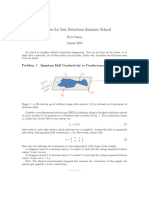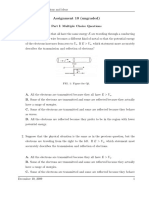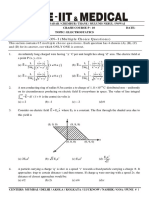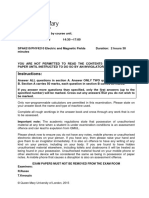EMTexam 08
EMTexam 08
Uploaded by
zcaptCopyright:
Available Formats
EMTexam 08
EMTexam 08
Uploaded by
zcaptOriginal Description:
Original Title
Copyright
Available Formats
Share this document
Did you find this document useful?
Is this content inappropriate?
Copyright:
Available Formats
EMTexam 08
EMTexam 08
Uploaded by
zcaptCopyright:
Available Formats
MSci EXAMINATION
PHY-966(4261) Electromagnetic Theory
Time Allowed: 2 hours 30 minutes
Date: May 2008
Time: hh:mm
Course Organiser: Prof WJ Spence
Deputy CO: Dr O Soloviev
Instructions: Answer THREE QUESTIONS only. Each ques-
tion carries 20 marks. An indicative marking-
scheme is shown in square brackets [ ] after each
part of a question. A formula sheet is provided at
the end of the examination paper.
YOU ARE NOT PERMITTED TO START READING THIS QUES-
TION PAPER UNTIL INSTRUCTED TO DO SO BY AN INVIG-
ILATOR
c Queen Mary, University of London 2008
!
This page should be blank
1. Maxwell’s equations in linear media are
∂D ∂B
∇ · D = ρ, ∇×H=J+ , ∇ · B = 0, ∇×E=− .
∂t ∂t
(i) Consider a region of space V bounded by a closed surface S, and
also let C be a closed contour in space with an open surface S !
spanning the contour. Explaining the notation used, derive from
the above equations the integral forms
∂D
! ! " !
D · dS = ρ dV, H · dl = (J + ) · dS!
S V C S! ∂t
∂B
! " !
B · dS = 0, E · dl = − · dS! . [6 marks]
S C S ! ∂t
(ii) Consider two regions, labelled by i = 1, 2, containing different
linear media, which meet at an infinite two-dimensional boundary,
with unit normal n to the boundary. Let Ei , Di , Bi , Hi for i = 1, 2
label the electromagnetic fields in the two regions.
Using a suitable small, shallow cylinder, straddling the boundary
between the two regions, with surface charge density σ, derive the
boundary conditions
(D2 − D1 ) · n = σ, (B2 − B1 ) · n = 0,
from two of the integral equations above.
Now considering a suitable small rectangle straddling the bound-
ary, with current density K on the surface of the rectangle, derive
the further boundary conditions
n × (H2 − H1 ) = K, n × (E2 − E1 ) = 0,
[8 marks]
(iii) Consider incident, refracted and reflected waves at this matter
interface, with
! !! ·x)
Einc = E0 e−i(ωt−k·x) , Eref r = E!0 e−i(ωt−k ·x) , Eref l = E!!0 e−i(ωt−k .
Assume that the matter interface is at z = 0, and that the incident
wave has electric field parallel to the z − x plane. Let the angles of
incidence, refraction and reflection be θ, θ! , θ!! respectively. Show
that the boundary conditions on the fields E at the interface imply
that
!! ! !
−E0 cos θeikx sin θ + E0!! cos θ!! eikx sin θ = −E0! cos θ! eik x sin θ
must be true for all x. Show that this implies that θ = θ!! (the
law of reflection), and k sin θ = k ! sin θ! (Snell’s law). [6 marks]
please turn to the next page
c Queen Mary, University of London 2008
! Page 1 of 6
2. For an oscillating electric dipole with strength p, oscillating in time as
e−iωt , the vector potential is given by
1 eikr ik
Ae.d. (r, t) = − p e−iωt ,
4π& r c
#
where r = (x, y, z), r = x2 + y 2 + z 2 and k = ω/c.
(i) Show that in the far zone, where kr >> 1, this results in the
magnetic field
1 k2 eikr −iωt
Be.d. (p) = n×p e
4π& c r
where n = 1r r. [4 marks]
(ii) For the electric field Ee.d. (p), use the source-free Maxwell equation
Ė = c2 ∇ × B and the fact that the time dependence of the fields
is e−iωt to deduce that
ic
Ee.d. (p) = ∇ × Be.d. (p) e−iωt
k
and hence that in the far zone
Ee.d. (p) = c Be.d. (p) × n .
[5 marks]
(iii) The vector potential for an oscillating magnetic dipole is given by
µ0 eikr
Am.d. (r, t) = ik n × m e−iωt .
4π r
Show that this is proportional to the magnetic field for the electric
dipole, with p replaced by m:
i
Am.d. = Be.d. (p → m).
kc
Thus prove that the electric and magnetic fields for a magnetic
dipole are given by
1 e.d.
Bm.d. (m) = E (p → m),
c2
Em.d. (m) = − Be.d. (p → m).
[8 marks]
(iv) How are the polarisation vectors, the directions of the magnetic
fields, and the directions of the radiation n oriented with respect
to each other in the two cases of electric and magnetic dipole
radiation in the far zone ?
[3 marks]
please turn to the next page
c Queen Mary, University of London 2008
! Page 2 of 6
3. (i) Show in the Lorentz gauge (∂ µ Aµ = 0), with Aµ = ( 1c Φ, A) and
j µ = (cρ, J), that the Maxwell equation ∂ µ Fµν = µ0 jν reduces to
1
∂ µ ∂µ A = µ0 J, ∂ µ ∂µ Φ = ρ.
&0
[3 marks]
$∞
(ii) Integrate the equation for A above with −∞
e−iωt to obtain the
Fourier transformed equation
(∇2 + k 2 )A(x, ω) = −µ0 J(x, ω), (1)
with k 2 = ω 2 /c2 . [4 marks]
(iii) Suppose that there exists a Green function Gk (x, x! ), satisfying
(∇2 + k 2 )Gk (x, x! ) = −4πδ 3 (x − x! ). (2)
Show that
µ0
!
A(x, ω) = Gk (x, x! )J(x! , ω)d3 x!
4π
solves equation (1) above. [3 marks]
(iv) Give an argument why Gk (x, x! ) must be purely a function of
r = |r| = |x − x! |. Show that in this case equation (2) becomes
1 d2
(rGk (r)) + k 2 Gk (r) = −4πδ 3 (r)
r dr2
and hence that when r &= 0, Gk (r) is given by
1
Gk (r) = (Aeikr + Be−ikr ), (3)
r
for some constants A, B. [5 marks]
ρ(r !
(v) A solution of Poisson’s equation ∇2 φ = − $10 ρ is φ = 4π$
1
d3 r! .
$
|r−r! |
Use this fact to show that when r → 0, (3) above remains a solu-
tion of equation (2) if
A + B = 1.
[5 marks]
please turn to the next page
c Queen Mary, University of London 2008
! Page 3 of 6
4. Consider the Maxwell equations in a vacuum with sources -
∂B
∇ · B = 0, ∇ × E = − ,
∂t
1 ∂E
∇·E= ρ, ∇ × B = µ0 &0 + µ0 J.
&0 ∂t
(i) Show that the first two of these equations may be solved by intro-
ducing the potentials A and Φ, and writing
∂A
B = ∇ × A, E = −∇Φ − .
∂t
Show that the other two Maxwell equations then become
∂ 1
∇2 Φ +
(∇ · A) = − ρ,
∂t &0
1 ∂ 2A 1 ∂Φ
∇2 A − 2 2 − ∇(∇ · A + 2 ) = −µ0 J.
c ∂t c ∂t
[6 marks]
(ii) Show that the definitions of the potentials are unchanged if we
make the gauge transformations
∂Λ
A → A + ∇Λ, Φ → Φ −
∂t
for any function Λ. [2 marks]
(iii) In Lorentz covariant notation, Maxwell’s equations above may be
written
∂µ Fνρ + ∂ν Fρµ + ∂ρ Fµν = 0, ∂ µ Fµν = −µ0 jν .
Show that the first of these equations is solved by writing
Fµν = ∂µ Aν − ∂ν Aµ .
Write down the gauge transformations on Aµ and show that they
leave Fµν invariant. [4 marks]
(iv) Consider Maxwell’s equations in the Coulomb gauge ∇ · A = 0.
Show that the equation for A can be written
1 ∂2A
∇2 A − = −µJt ,
c2 ∂t2
where Jt is transverse (∇ · Jt = 0). You may use the result that
∇2 |x!1−x| = −4πδ 3 (x! − x) and the identities ∇2 J = ∇∇ · J − ∇ ×
∇ × J, and J(x) = δ 3 (x! − x)J(x! ) d3 x! for any vector field J.
$
[8 marks]
please turn to the next page
c Queen Mary, University of London 2008
! Page 4 of 6
5. The electric and magnetic fields generated by a charged particle moving
with velocity cβ and acceleration cβ̇ are given by the Lienard-Wiechert
expressions
1
B = [n × E]ret ,
c
q % n−β & q 1 % n × [(n − β) × β̇] &
E= + ,
4π&0 γu2 R2 (1 − β · n)3 ret 4π&0 c (1 − β · n)3 R ret
where n is the unit vector which points from the point on the particle
trajectory to the field point x, with x = r(τ0 ) = nR, and the retarded
time is tret = t − R/c.
(i) Show that for the case when the acceleration is parallel to the
velocity, the electric field far from the charge is given by
q 1 % n × [n × β̇] &
E= .
4π&0 c (1 − β · n)3 R ret
[2 marks]
1
(ii) Show that in this case, the Poynting vector S = µ0
E × B, far from
the charge is
q2 1 % β̇ sin θ &2
S= n,
4π&0 4πc (1 − β · n)3 R ret
where θ is the angle between n and the common direction of the
velocity and acceleration of the particle. [4 marks]
(iii) Show that the power radiated per unit solid angle is given by
dP (t! ) dt
= R2 n · S ! .
dΩ dt
and hence equals
dP (t! ) q2 1 β̇ 2 sin2 θ
= .
dΩ 4π&0 4πc (1 − β cos θ)5
[6 marks]
(iv) For non-relativistic motion, deduce from this the Larmor formula
dP q2 1 2 2
= u̇ sin θ.
dΩ 4π&0 4πc3
[2 marks]
(v) Without making the non-relativistic approximation, show that the
maximum intensity of radiation is observed at the angle
% 1 #
θmax = cos−1 ( 1 + 15β 2 − 1).
3β
[6 marks]
please turn to the next page
c Queen Mary, University of London 2008
! Page 5 of 6
Formula Sheet
a × (b × c) =(a · c)b − (a · b)c,
∇ · (ψa) = a · ∇ψ + ψ∇ · a,
∇ × (ψa) = (∇ψ) × a + ψ(∇ × a),
∇'× (∇(× a) = ∇(∇ · a) − ∇2 a,
∇ ψ(r) = nψ ! (r).
Maxwell’s equations:
∇ · B = 0, ∇ × E = − ∂B
∂t
;
∇ · D = ρ, ∇ × H = J + ∂D
∂t
.
F = q(E + v × B).
∇ · J + ρ̇ = 0.
For linear isotropic media:
1 1
D = &E = &0 E + P, H= B = B − M.
µ µ0
c2 dτ 2 = c2 dt2 − dx2 − dy 2 − dz 2 = dxα ηαβ dxβ .
)+1 if α = β = 0
ηαβ = −1 if α = β = 1, 2, 3
0 if α &= β
∂ *1 ∂ +
µ
*1 ∂ +
∂µ = = ,∇ , ∂ = , −∇ .
∂xµ c ∂t c ∂t
∂α F αβ = ∂α ∂ α Aβ − ∂ β ∂α Aα = µ0 j β ; F αβ = ∂ α Aβ − ∂ β Aα .
∂α Fβγ + ∂β Fγα + ∂γ Fαβ = 0.
−E 1 /c −E 2 /c −E 3 /c
0
E 1 /c 0 −B 3 B2
'F αβ ' =
E 2 /c
.
B3 0 −B 1
E 3 /c −B 2 B1 0
In spherical coordinates (r, θ, φ), for a scalar field G(r, θ, φ),
1 ∂2 ∂2G
2 3
2 1 ∂ ∂G 1
∇ G= (rG) + 2 sin θ + 2 2 .
r ∂r2 r sin θ ∂θ ∂θ r sin θ ∂φ2
$ ρ(r! 3 !
A solution of Poisson’s equation ∇2 φ = − $10 ρ is φ = 4π$1
|r−r! |
d r.
End of Examination Paper Prof WJ Spence
c Queen Mary, University of London 2008
! Page 6 of 6
You might also like
- Method Statement For Testing of Installed Hdpe LinersNo ratings yetMethod Statement For Testing of Installed Hdpe Liners9 pages
- W. J. Beek, K. M. K. Muttzall, J. W. Van Heuven Transport Phenomena PDF100% (2)W. J. Beek, K. M. K. Muttzall, J. W. Van Heuven Transport Phenomena PDF303 pages
- Absorption and Dispersion in Conducting Media: PYL100: Electromagnetic Waves and Quantum MechanicsNo ratings yetAbsorption and Dispersion in Conducting Media: PYL100: Electromagnetic Waves and Quantum Mechanics31 pages
- Msci Examination: Phy-415 (Msci 4242) Relativistic Waves and Quantum FieldsNo ratings yetMsci Examination: Phy-415 (Msci 4242) Relativistic Waves and Quantum Fields7 pages
- Electromagnetism: Example Sheet 3: inc 0 i (kz−ωt) inc 0 i (kz−ωt)No ratings yetElectromagnetism: Example Sheet 3: inc 0 i (kz−ωt) inc 0 i (kz−ωt)3 pages
- 3.23 Electrical, Optical, and Magnetic Properties of MaterialsNo ratings yet3.23 Electrical, Optical, and Magnetic Properties of Materials6 pages
- Plane-Wave Solutions of Maxwell's Equations: An Educational NoteNo ratings yetPlane-Wave Solutions of Maxwell's Equations: An Educational Note12 pages
- Drift Model of A Glow Discharge With Account For The Nonlocal Value of The Electric Field Strength in The Ionization SourceNo ratings yetDrift Model of A Glow Discharge With Account For The Nonlocal Value of The Electric Field Strength in The Ionization Source6 pages
- Optical Properties of Semiconductors: Tewodros AdaroNo ratings yetOptical Properties of Semiconductors: Tewodros Adaro27 pages
- Figure(s) in the margin indicate(s) each mark(s) 1: E B ϵ E μ B ϵ E B BNo ratings yetFigure(s) in the margin indicate(s) each mark(s) 1: E B ϵ E μ B ϵ E B B3 pages
- Assignment 10 (Ungraded) : FIG. 1: Figure For Q1No ratings yetAssignment 10 (Ungraded) : FIG. 1: Figure For Q14 pages
- Neet On Line Test On Physics (Electric Charges & Fields & Electrostatics & Potential & Capacitance) .28.10.2024 (Solutions)No ratings yetNeet On Line Test On Physics (Electric Charges & Fields & Electrostatics & Potential & Capacitance) .28.10.2024 (Solutions)9 pages
- Electrodinamica Classica 2024 Semana 1 Supplementarios SolsNo ratings yetElectrodinamica Classica 2024 Semana 1 Supplementarios Sols4 pages
- Coductor Boundary Conditions (Compatibility Mode)No ratings yetCoductor Boundary Conditions (Compatibility Mode)63 pages
- P-10, Crash Course Assignment (Electrostatics)No ratings yetP-10, Crash Course Assignment (Electrostatics)5 pages
- MO2024_PH24101_TutorialQuestions_Module2_ClassNo ratings yetMO2024_PH24101_TutorialQuestions_Module2_Class10 pages
- 22.101 Applied Nuclear Physics (Fall 2006) Lecture 8 (10/4/06) Neutron-Proton ScatteringNo ratings yet22.101 Applied Nuclear Physics (Fall 2006) Lecture 8 (10/4/06) Neutron-Proton Scattering7 pages
- CBSE-XII Physics Chap-8 (Electromagnetic Waves) external notesNo ratings yetCBSE-XII Physics Chap-8 (Electromagnetic Waves) external notes8 pages
- Solving Electromagnetic Eigenvalue Problems in Polyhedral Domains With Nodal Finite Elements100% (1)Solving Electromagnetic Eigenvalue Problems in Polyhedral Domains With Nodal Finite Elements20 pages
- Problems in Quantum Mechanics: Third EditionFrom EverandProblems in Quantum Mechanics: Third EditionD. ter Haar3/5 (2)
- BSC and Msci Examination: © Queen Mary, University of London, 2012No ratings yetBSC and Msci Examination: © Queen Mary, University of London, 20128 pages
- Instructions:: Exam Papers Must Not Be Removed From The Exam Room Examiners: R.Russo T.KreouzisNo ratings yetInstructions:: Exam Papers Must Not Be Removed From The Exam Room Examiners: R.Russo T.Kreouzis9 pages
- Problem Sheet 3 Heat, Work and The First Law of Thermodynamics PDFNo ratings yetProblem Sheet 3 Heat, Work and The First Law of Thermodynamics PDF4 pages
- Grade 2 Study Guide - Science - SOL 2.6 Weather Vocabulary100% (2)Grade 2 Study Guide - Science - SOL 2.6 Weather Vocabulary4 pages
- Group 5 TPP Exp2 Gas Absorption Unit ReportNo ratings yetGroup 5 TPP Exp2 Gas Absorption Unit Report38 pages
- Well Problems and Solutions, Well Problem, SolutionsNo ratings yetWell Problems and Solutions, Well Problem, Solutions16 pages
- Prestressed, Post-Tensioned Concrete Section (ACI 318-08)No ratings yetPrestressed, Post-Tensioned Concrete Section (ACI 318-08)52 pages
- Polymerization: Process of Combining Large Number of MonomersNo ratings yetPolymerization: Process of Combining Large Number of Monomers17 pages
- Instant download Hybrid Perovskite Solar Cells Characteristics and Operation 1st Edition Hiroyuki Fujiwara (Editor) pdf all chapter100% (3)Instant download Hybrid Perovskite Solar Cells Characteristics and Operation 1st Edition Hiroyuki Fujiwara (Editor) pdf all chapter61 pages
- Method Statement For Testing of Installed Hdpe LinersMethod Statement For Testing of Installed Hdpe Liners
- W. J. Beek, K. M. K. Muttzall, J. W. Van Heuven Transport Phenomena PDFW. J. Beek, K. M. K. Muttzall, J. W. Van Heuven Transport Phenomena PDF
- Absorption and Dispersion in Conducting Media: PYL100: Electromagnetic Waves and Quantum MechanicsAbsorption and Dispersion in Conducting Media: PYL100: Electromagnetic Waves and Quantum Mechanics
- Msci Examination: Phy-415 (Msci 4242) Relativistic Waves and Quantum FieldsMsci Examination: Phy-415 (Msci 4242) Relativistic Waves and Quantum Fields
- Electromagnetism: Example Sheet 3: inc 0 i (kz−ωt) inc 0 i (kz−ωt)Electromagnetism: Example Sheet 3: inc 0 i (kz−ωt) inc 0 i (kz−ωt)
- 3.23 Electrical, Optical, and Magnetic Properties of Materials3.23 Electrical, Optical, and Magnetic Properties of Materials
- Plane-Wave Solutions of Maxwell's Equations: An Educational NotePlane-Wave Solutions of Maxwell's Equations: An Educational Note
- Drift Model of A Glow Discharge With Account For The Nonlocal Value of The Electric Field Strength in The Ionization SourceDrift Model of A Glow Discharge With Account For The Nonlocal Value of The Electric Field Strength in The Ionization Source
- Optical Properties of Semiconductors: Tewodros AdaroOptical Properties of Semiconductors: Tewodros Adaro
- Figure(s) in the margin indicate(s) each mark(s) 1: E B ϵ E μ B ϵ E B BFigure(s) in the margin indicate(s) each mark(s) 1: E B ϵ E μ B ϵ E B B
- Neet On Line Test On Physics (Electric Charges & Fields & Electrostatics & Potential & Capacitance) .28.10.2024 (Solutions)Neet On Line Test On Physics (Electric Charges & Fields & Electrostatics & Potential & Capacitance) .28.10.2024 (Solutions)
- Electrodinamica Classica 2024 Semana 1 Supplementarios SolsElectrodinamica Classica 2024 Semana 1 Supplementarios Sols
- 22.101 Applied Nuclear Physics (Fall 2006) Lecture 8 (10/4/06) Neutron-Proton Scattering22.101 Applied Nuclear Physics (Fall 2006) Lecture 8 (10/4/06) Neutron-Proton Scattering
- CBSE-XII Physics Chap-8 (Electromagnetic Waves) external notesCBSE-XII Physics Chap-8 (Electromagnetic Waves) external notes
- Solving Electromagnetic Eigenvalue Problems in Polyhedral Domains With Nodal Finite ElementsSolving Electromagnetic Eigenvalue Problems in Polyhedral Domains With Nodal Finite Elements
- Problems in Quantum Mechanics: Third EditionFrom EverandProblems in Quantum Mechanics: Third Edition
- BSC and Msci Examination: © Queen Mary, University of London, 2012BSC and Msci Examination: © Queen Mary, University of London, 2012
- Instructions:: Exam Papers Must Not Be Removed From The Exam Room Examiners: R.Russo T.KreouzisInstructions:: Exam Papers Must Not Be Removed From The Exam Room Examiners: R.Russo T.Kreouzis
- Problem Sheet 3 Heat, Work and The First Law of Thermodynamics PDFProblem Sheet 3 Heat, Work and The First Law of Thermodynamics PDF
- Grade 2 Study Guide - Science - SOL 2.6 Weather VocabularyGrade 2 Study Guide - Science - SOL 2.6 Weather Vocabulary
- Well Problems and Solutions, Well Problem, SolutionsWell Problems and Solutions, Well Problem, Solutions
- Prestressed, Post-Tensioned Concrete Section (ACI 318-08)Prestressed, Post-Tensioned Concrete Section (ACI 318-08)
- Polymerization: Process of Combining Large Number of MonomersPolymerization: Process of Combining Large Number of Monomers
- Instant download Hybrid Perovskite Solar Cells Characteristics and Operation 1st Edition Hiroyuki Fujiwara (Editor) pdf all chapterInstant download Hybrid Perovskite Solar Cells Characteristics and Operation 1st Edition Hiroyuki Fujiwara (Editor) pdf all chapter







